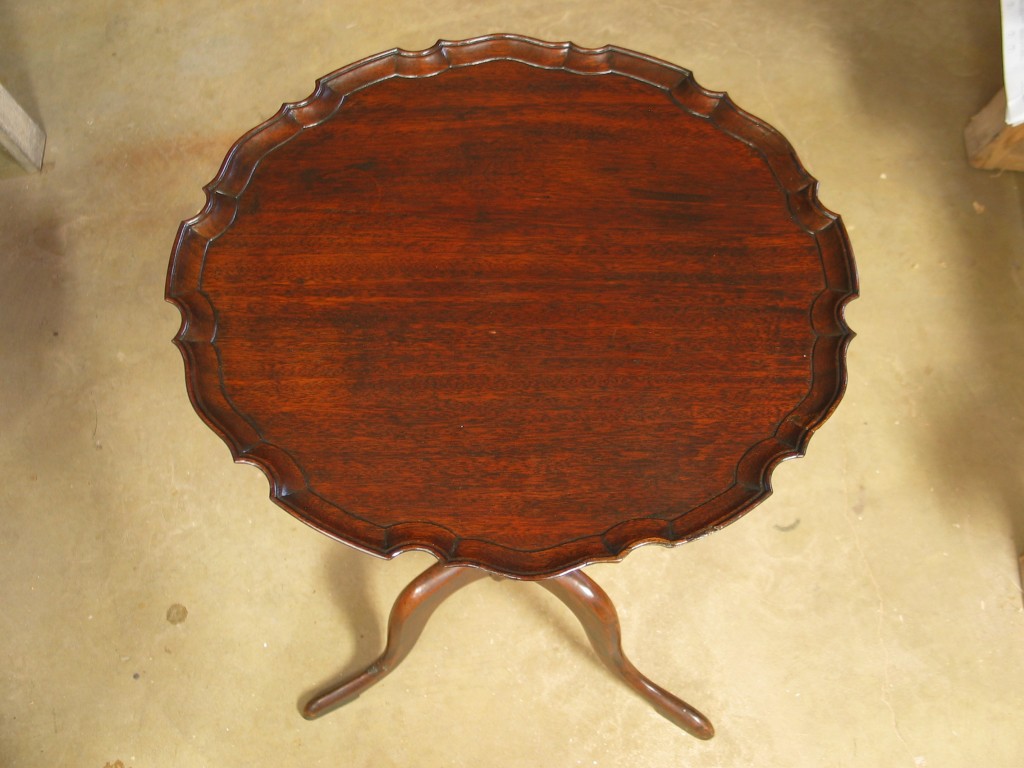We may receive a commission when you use our affiliate links. However, this does not impact our recommendations.

Early nineteenth-century pie-crust table. Pin this!
It’s widely believed and promoted that the proper finish for 18th and 19th-century antique furniture and reproductions is shellac. The reason is that shellac was the finish that was most likely used in that time period.
I have no problem with this, but I want to make the case that nitrocellulose lacquer is also appropriate. Here’s the main consideration when choosing a finish for very old furniture and for reproductions of this furniture: Can the finish be removed easily without damaging the wood?
If the furniture is well made, it should last a very long time and will probably need to be refinished at some point. No finish lasts forever, or even close to as long as the wood. Only if the furniture is kept shielded from light can the finish be expected to last for more than 75 or 100 years. When it begins crazing (caused primarily by light exposure), it loses its primary functions of decorating and protecting the wood. If you care about the longevity of the furniture, you want it to be possible for someone in the future to remove the finish you are applying without damaging the wood.
Most pre-twentieth-century furniture is fairly elaborate, with carvings, turnings, moldings, fluting, etc. If you use a finish that has to be abraded to get it out of recesses, even with the aid of a paint stripper, you will inevitably damage the wood in some way. Steel wool and scrub pads can’t help, but will scratch the wood and sandpaper will round over sharp edges, dulling the beauty of the decoration.
Shellac and lacquer (nitrocellulose or CAB-acrylic) are the easiest to remove without causing damage. Both can be “washed” off the wood without using any abrasives because both dissolve in paint stripper, alcohol (shellac), or lacquer thinner (lacquer).
No other finish (except wax if you count this as a finish) dissolves, though some water-based finishes can be broken down with a lot of paint stripper. I say “some” because the direction water-based finishes seem to be taking is increased resistance to attack by any solvent.
So lacquer provides this reversibility just as well as shellac does. The practical difference is that lacquer has several advantages over shellac, which might influence your choice. The most important is that lacquer is available in various sheens and shellac isn’t; shellac is always gloss. So it’s easy with lacquer to make the finish look older by using a satin or flat sheen.
There are also several application advantages of lacquer. Because the lacquer-thinner solvent is composed of half-a-dozen solvents that evaporate at different rates, it’s easier to spray vertical surfaces without runs or sags. And because of the availability of lacquer retarder and acetone, it’s easier to control the drying rate in cold, hot or damp weather conditions. Add acetone to speed the drying in cold temperatures, and add lacquer retarder to eliminate dry spray and blushing in hot and/or damp conditions.
Also, lacquer is a less challenging finish to use, especially if you are using a spray gun. I wrote an entire article about the challenges of shellac for the April, 2011 issue of Popular Woodworking Magazine.
I want to emphasize that I’m not saying that choosing shellac is wrong. I’m only saying that using lacquer is OK too.
Here are some supplies and tools we find essential in our everyday work around the shop. We may receive a commission from sales referred by our links; however, we have carefully selected these products for their usefulness and quality.












Bob,
It’s my experience that spraying lacquer will devalue the piece. while this might not be as critical on a 1920’s repro tilt top it would be detrimental to say a regency rosewood sideboard or other early pieces.
The feel is different and lacquer doesn’t wax anything like shellac. if you wash a period finish with Denatured Alcohol you shouldn’t have to worry about the gunk in the carving and recesses, after all isn’t that what we like about the antique to begin with. Lastly I have never or will I sand a period antique.Again I think that takes away from what we love about the object.
Glad you posted this article Bob. I use lacquer near daily and get frowned at by some ofbthe restoration purests. So many antique restorers push the oil/varnish finishes. Lacquer is such a versatile, superb finish. The furniture repairman’s friend. Most people don’t realize that next to animal fats the first lacquers in China 6000 yrs ago were probably the oldest of all finishes. Keep up the good work.
How does removing the finish as you explain above affect the patina? I have a nice 1840’s New England 2 drawer drop leaf table in good condition I would like to restore. It has nice crotch mahogany veneer on the drawer fronts. I’d hate to lose that patina.